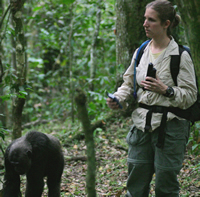Anthropologist Sees Chimp Aggression in Uganda
When Michigan native Dr. Sylvia Amsler enrolled at Valparaiso University in Indiana, she was interested in being a music therapist of some kind. Then she read Jane Goodall’s “My Life with the Wild Chimpanzees” and took an introductory class in anthropology. Her destiny changed. “I was hooked,” the UALR Department of Anthropology instructor said. She joined the department in spring 2009 after finishing a Ph.D. from the University of Michigan and a 19-month study of chimpanzees living at Ngogo in Uganda’s Kibale National Park.
Her work with mentor John Mitani, a primate behavioral ecologist at the University of Michigan, is making international news this week. Their research published in Current Biology provides the first clear direct evidence that chimp violence is clearly related to increases in territory size.
The researchers watched two groups of chimps, one of them with 150 members and a disproportionate number of males. The scientists observed the Ngogo chimpanzees kill or fatally wound 18 individuals from other groups. They documented unusual chimpanzee boundary patrols in which the animals moved quickly, silently, and in single file, carefully watching for other chimpanzees. Amsler witnessed one of several attacks.
“They had been on patrol outside of their territory for more than two hours when they surprised small group of females from the community to the northwest,” Amsler said. “Almost immediately upon making contact the adult males in the patrol party began attacking the unknown females, two of whom were carrying dependent infants.”
Soon after the killings, the researchers noticed that the Ngogo chimpanzees expanded their territory considerably — by more than 22 percent — into the same area where the majority of lethal attacks had been observed.
Amsler’s fascination with chimpanzees — the closest evolutionary relative of humans — was honed by her work as a zookeeper at the Little Rock Zoo where she looked after primates from 1997 to 2001 before heading to graduate school in Michigan.
Today, she is a liaison for the Department of Sociology and Anthropology and the Little Rock Zoo in a volunteer program that provides undergraduates the opportunity for hands-on experience with the zoo’s Great Apes department, a program developed by the late UALR Professor Mark Hartmann.
At UALR, Amsler teaches courses in physical anthropology — including an introductory course and upper-level courses in primate and human behavior in evolutionary perspective and introduction to primates.
“I find the students at UALR very engaged and very motivated,” she said. “As am I.”
“I was hooked,” the UALR Department of Anthropology instructor said. She joined the department in spring 2009 after finishing a Ph.D. from the University of Michigan and a 19-month study of chimpanzees living at Ngogo in Uganda’s Kibale National Park.
Her work with mentor John Mitani, a primate behavioral ecologist at the University of Michigan, is making international news this week. Their research published in Current Biology provides the first clear direct evidence that chimp violence is clearly related to increases in territory size.
The researchers watched two groups of chimps, one of them with 150 members and a disproportionate number of males. The scientists observed the Ngogo chimpanzees kill or fatally wound 18 individuals from other groups. They documented unusual chimpanzee boundary patrols in which the animals moved quickly, silently, and in single file, carefully watching for other chimpanzees. Amsler witnessed one of several attacks.
“They had been on patrol outside of their territory for more than two hours when they surprised small group of females from the community to the northwest,” Amsler said. “Almost immediately upon making contact the adult males in the patrol party began attacking the unknown females, two of whom were carrying dependent infants.”
Soon after the killings, the researchers noticed that the Ngogo chimpanzees expanded their territory considerably — by more than 22 percent — into the same area where the majority of lethal attacks had been observed.
Amsler’s fascination with chimpanzees — the closest evolutionary relative of humans — was honed by her work as a zookeeper at the Little Rock Zoo where she looked after primates from 1997 to 2001 before heading to graduate school in Michigan.
Today, she is a liaison for the Department of Sociology and Anthropology and the Little Rock Zoo in a volunteer program that provides undergraduates the opportunity for hands-on experience with the zoo’s Great Apes department, a program developed by the late UALR Professor Mark Hartmann.
At UALR, Amsler teaches courses in physical anthropology — including an introductory course and upper-level courses in primate and human behavior in evolutionary perspective and introduction to primates.
“I find the students at UALR very engaged and very motivated,” she said. “As am I.” View more stories in News
